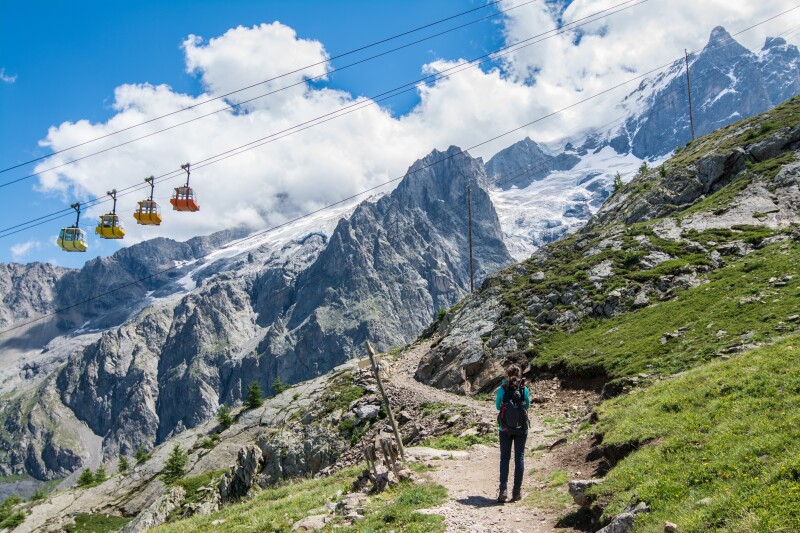The best thing about Europe’s national parks? They may lack the size of their U.S. counterparts, but they sure do pack a compact punch. Iceland’s Vatnajökull National Park is one example, a place where I crawled through tunnels of glacier ice, speed-boated around icebergs that flipped and calved, and felt the thunderous power of Dettifoss waterfall as it churned beneath me.
These seven national parks offer plenty of adventures within their borders and have so much more to explore beyond their headline-grabbing hot spots.
1. Plitvice Lakes National Park, Croatia
Plitvice Lakes is not only the oldest national park in the country but also the largest at around 115 square miles. Day-trippers come from Zagreb to spend a morning or afternoon at the series of 16 color-changing lakes laced together across tumbling waterfalls, but the smart way is to stay longer. Enjoy boardwalk hikes, electric boat rides, and buses on one of the park’s full-day routes such as “K”: This journey includes Big Waterfall, Lower Lakes canyon, the Prštavci waterfalls, and the April 2024–opened Tomićevo Pogledalo viewpoint.

In 2022, Thethi and Valbona National Parks combined to establish Alps of Albania National Park.
Photo by Mazur Travel/Shutterstock
2. Alps of Albania National Park, Albania
Formerly two parks that were seamed together by the ominously named Accursed Mountains, Alps of Albania National Park was established in 2022. In this nearly 22,000-acre park, travelers can walk trails up to high farming hamlets beneath cathedrals of rock or over the Albanian Alps massif and down into the beech and fir forests of Theth.
Several simple family-run hotels (stay at Pisha Villa in Theth or Guesthouse Mehmeti in Valbona) offer home-cooked meals and the chance to try locally brewed slivovitz, an alcoholic tipple made from plums. Fifteenth-century fortified buildings known as lock-in towers, from the days when Kanun rule allowed “eye for an eye” blood feuds between families, dot the landscape and whisper of the area’s past. Guided tours with companies such as Explore make the circuit an insightful and carefree option.

Learn about prehistoric history at Brú na Bóinne National Park in places like the Newgrange Passage Tomb.
Photo by MNStudio/Shutterstock
3. Brú na Bóinne National Park, Ireland
The beauty of Ireland’s Brú na Bóinne National Park, located an hour from Dublin, is not the park’s rivers and hills but what lies beneath them. Archaeological treasures abound: There’s the 5,000-year-old Newgrange Passage Tomb, with its white circular walls and grass-covered roof hiding one of the oldest-known human calendars. Every year on the winter solstice, sunlight slips through a slit in the monument’s rocky ceiling and floods the tomb with light. There are also ring forts, a Norman-period castle, Georgian Dowth Hall, and Victorian Netterville Manor.

Estonia is dotted with raised bogs, peaty wetlands that do double duty as carbon sinks.
Photo by Billie Cohen
4. Soomaa National Park, Estonia
Two hours south of the capital, Tallinn, are the wetlands of Soomaa—literally translated as “land of bogs.” Soomaa locals are unapologetic about the flooding that regularly occurs between spring and summer. Instead, those inundations are celebrated as a “fifth season,” during which visitors can take UNESCO-recognized haabjas dugout boats to navigate the terrain.
Explore the many wooden boardwalks or hike off-piste among forests of ash, spruce, elm, and oak in special bog shoes. Open-water swimming in the mineral-rich bogs is encouraged, and camping, bird-watching, and beaver safaris are popular. In winter when the bogs freeze, ice skate or kick sled before a retreat into a smoke sauna (which has no chimney and is heated for six hours before being ventilated, meaning a lingering smokey scent) for an authentically Estonian wilderness experience.

Vatnajökull National Park features ice caves and active volcanoes.
Photo by Zhukova Valentyna/Shutterstock
5. Vatnajökull National Park, Iceland
Vatnajökull National Park takes up a huge swath of the country, which makes it one of the largest national parks in Europe at around 5,780 square miles. There are extreme activities available: Think glacier hiking, climbing, and ice cave exploring—all possible even for novices with the assistance of a guide. But there’s also the serene at Vatnajökull: Cruise on inflatable Zodiac boats amid seals and icebergs on Jökulsárlón, hike to one of several waterfalls, and wander Diamond Beach’s black sands strewn with ice crystals.

Écrins National Park is in southeastern France.
Photo by Martin Blazicek/Shutterstock
6. Écrins National Park, France
Easily reached on a sleeper train from Paris (disembark at Briançon), Écrins is perhaps more familiar to skiers than hikers, thanks to its location near the Serre Chevallier resort. Écrins is nonetheless a stronghold for glaciers; there are more than 40 within its borders. There are also more than 100 mountains and some 400 miles of ancient shepherds trails to hike. Further accentuating the isolated vibe of Écrins, the park is home to the Réserve intégrale du Lauvite, a wilderness preserve established in 1995 to study what happens to a place when all human activity is removed. Accommodations are mainly mountain huts, but the scenery is in a league entirely its own.

Broads National Park covers about 117 square miles.
Photo by James LePage/Shutterstock
7. Broads National Park, England
Broads National Park covers only 0.1 percent of Britain. But this man-made mosaic of 124 miles of navigable waterways and protected wetlands is home to a quarter of the country’s rarest wildlife species: See harbor porpoises, water voles, otters, and birds like the bittern (locally known as the butterbump), which boasts a mating call detectable a mile away.
Near the east coast of Norfolk County, Broads is also the ultimate place for waterside adventure. Sit on a riverbank, paddleboard, or a rented houseboat with a pair of binoculars and watch the world go by. Aside from its wildlife residents, there are homely pubs where two-legged visitors can sample regional foods, such as Norfolk mussels and crunch rolls (bread made from malted wheat grains).











